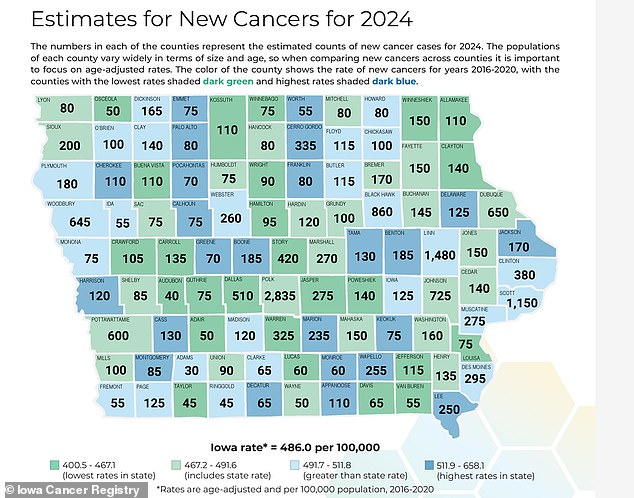Health officials are struggling to figure out why Iowa has become a cancer hotspot in the United States.
Unlike most U.S. states, Iowa is among a few where cancer rates have increased over the past five years. It has the second-highest rate of diagnoses: about 480 per 100,000 people, according to the National Cancer Institute.
This is higher than the national average of 442 cases per 100,000 people.
In 2024, about 21,000 Iowans are expected to be diagnosed with cancer, which, considering their population, represents the second-highest proportion of diagnoses in the country.
Two issues are feared to be behind the cancer surge: water, soil and air contaminated by chemicals used in the state’s booming agricultural industry and Iowa’s growing alcohol problem.



Dr. Nathan Goodyear, medical director of a comprehensive cancer center in Arizona, told DailyMail.com that both alcohol and pesticides are two of the main contributors to an “inhospitable environment” that can increase the risk of cancer.
Agriculture in Iowa accounts for $17.3 billion of the state’s $247 billion gross domestic product, about seven percent. It is the third largest industry in the state.
The state’s two main crops are corn and soybeans, which require large amounts of pesticides and fertilizers.
The state uses 237 million pounds of herbicides and 11.6 billion pounds of fertilizers per year, more than any other state. The level of fertilizer use represents 28 percent of the country’s total each year.
And Iowa’s livestock and poultry industry produces more waste annually than any other state: 109 billion pounds.
Both pesticides and nitrates from animal waste commonly drain from farms into water sources, and exposure to them has been associated with an increased risk of brain, breast, bladder, liver, bile duct, and ovarian cancers, as well as non-Hodgkin lymphoma.
David Cwiertny, professor of civil and environmental engineering at the University of Iowa, said the Iowa capital office: ‘Here we are unique in terms of our production system. Unmatched anywhere in the world, right?
‘We are proud to boast about it. But we shouldn’t be so foolish as to think that the incomparable scale of production carries no unique consequences or challenges for our state, right?
Dr Goodyear told DailyMail.com that pesticides and agricultural chemicals disrupt hormones, increase inflammation, disrupt the body’s immune system and reduce oxygen levels in cells and tissues.
He said: “Destroy or damage the cell’s ability to produce energy, and the means of living are destroyed.”
Cancer, Dr. Goodyear added, is the result of long-term changes made to the body’s cells as they attempted to adapt to the “inhospitable environment” caused by external factors.
But experts are starting to think that agriculture isn’t the only explanation, especially given the rise in cancers in the state.
Iowa has one of the highest rates of binge drinking in the U.S., with 22 percent of residents reporting the habit, compared to the national average of 17 percent.
The rate of alcohol-related cancers in the state has increased since 2014 and has about 10 times more cases than the U.S. average, according to Cancer in Iowa. report published by the Iowa Cancer Registry last month.


Alcohol, a known carcinogen, It can increase the risk of cancer because it damages cells and inhibits their ability to repair themselves, which can cause normal cells to become cancerous.
Dr. Goodyear said alcohol, like chemicals, is just an “additional contribution to a crisis (within) the body’s internal environment” that can lead to cellular adaptation and death.
Excessive alcohol consumption has been linked to alcohol-related cancers, including breast cancer in women; liver; colorectal; and head and neck, which includes lip, mouth, pharynx, larynx, and esophagus.
Compared to people who do not drink, those who regularly consume large amounts of alcohol have a five times greater risk of developing cancers of the mouth, esophagus and nasal cavity and a 2.5 times greater risk of throat cancer.
Currently, Iowa has the second-highest rate of new oral and nasal cavity cancers and the fourth-highest rate of new esophageal cancer cases in the country.
The report It is estimated that in 2024 there will be 21,000 new cancer diagnoses in Iowa and 6,100 residents will die from some form of the disease.
The cancer that is expected to have the highest incidence is breast cancer, which will see 2,930 diagnoses. It is followed by prostate with 2,850 new cases and lung cancer with 2,700 diagnoses.
The largest number of deaths will occur from lung cancer, with an estimate of 1,430, followed by 550 deaths from colon and rectal cancer and 470 deaths from pancreatic cancer.
While the latest report highlights the impact of alcohol on cancer, the authors said ‘there is no single cause for cancer; rather it is the complex interaction of different genetic, behavioral, environmental and structural factors that leads to the disease.
However, to reduce risks, it is important for people to address anything they have control over, such as alcohol consumption.
